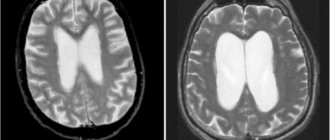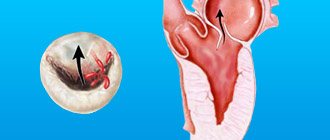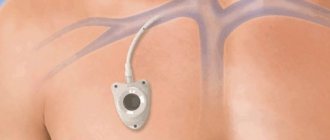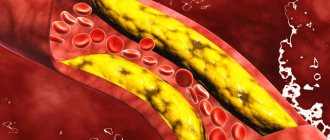Anticoagulant therapy is a set of therapeutic measures aimed at inhibiting blood clotting activity and preventing the formation of blood clots. The use of anticoagulants makes it possible to have a targeted effect on different parts of the blood coagulation process. This makes it possible to use them in a number of serious pathological conditions.
CELT phlebologists are well acquainted with the principles of anticoagulant therapy and have been successfully applying them in practice for several years. They carry out an individual selection of appropriate drugs, preventing the development of such dangerous conditions as thrombosis and blockage of blood vessels. Their efforts reduce the risk of heart attacks and strokes.
Our doctors
Drozdov Sergey Alexandrovich
Cardiovascular surgeon, phlebologist, Doctor of Medical Sciences
47 years of experience
Make an appointment
Malakhov Yuri Stanislavovich
Doctor - cardiovascular surgeon, phlebologist, Honored Doctor of the Russian Federation, Doctor of Medical Sciences, doctor of the highest category
Experience 36 years
Make an appointment
Possible adverse reactions
The risk of developing negative symptoms after taking anticoagulants is increased if the following factors are present:
- with the development of diseases that are contraindications to taking medications (renal failure, etc.);
- when taken simultaneously with other drugs with which anticoagulants are incompatible;
- when treating patients over 65 years of age;
- with a history of stroke and gastrointestinal bleeding.
Advertising:
The most common side symptom is internal bleeding. Other negative manifestations include:
- skin symptoms characteristic of an allergic reaction of the body: rash, itching, burning, areas with hyperemia, etc.;
- necrotic changes in the epidermis caused by thrombosis of veins and capillaries localized in the subcutaneous fat layer;
- symptoms of general intoxication: headache, weakness, febrile syndrome;
- clinical manifestations from the digestive system: nausea and vomiting, pain in the epigastric region, the formation of ulcerative tumors in the oral cavity;
- dysfunction of the liver and kidneys;
- Among the long-term side symptoms (occurring after 1-2 weeks of anticoagulant therapy) are cholesterol microembolism, leukopenia, and agranulocytosis.
To prevent the development of negative reactions, before starting to take anticoagulants, you need to visit a doctor who will prescribe the correct dosage and determine the maximum possible duration of treatment.
Indications and contraindications for anticoagulant therapy
Anticoagulants are substances that inhibit blood clotting activity. They have a wide spectrum of action, minimizing exacerbations of diseases of the cardiovascular system in the form of strokes and heart attacks. By starting treatment with anticoagulants in a timely manner, it is possible to prevent the formation of blood clots in blood vessels with their subsequent blockage and the development of a number of serious complications.
Usually blood clots are tightly fixed to the walls of blood veins, but under the influence of blood flow, elevated temperature, blood pressure or physical stress they can come off. This situation arises suddenly, and a person’s life in it depends on how correctly and quickly medical care is provided to him. The consequences can be the most tragic: from stroke and heart attack to pulmonary embolism and thrombosis of the leg veins. Correct use of anticoagulants can eliminate these complications.
| Indications for anticoagulant therapy: | Contraindications to the use of anticoagulants: |
| Taking anticoagulants is not recommended for pregnant women, as it can cause disturbances in the embryonic development of the fetus and bleeding during the gestational period. It is also not recommended for patients suffering from:
|
Introduction
Hypercoagulability is common in patients with severe COVID-19 and increases the risk of adverse outcomes such as progressive respiratory failure, acute respiratory distress syndrome, and death [1–8].
The most common pattern of coagulopathy observed in patients hospitalized with COVID-19 is characterized by increased levels of fibrinogen, D-dimer, moderate prolongation of prothrombin time (PT) and activated partial thromboplastin time (APTT). This correlates with a concomitant increase in inflammatory markers (eg, C-reactive protein). In contrast to the picture of classic DIC (disseminated intravascular coagulation syndrome) observed in bacterial sepsis or trauma, the degree of increase in aPTT is often lower than the increase in PT (probably due to increased levels of factor VIII), thrombocytopenia is moderate (platelet count about 100 thousand/µl) and there is no microangiopathy. The American Society of Hematology has proposed using the term “COVID-19-associated coagulopathy” to refer to this condition [4].
Elevated D-dimer levels on admission and significant (3- to 4-fold) increases in D-dimer levels during hospitalization are associated with high mortality, likely reflecting activation of coagulation factors as a result of infection and/or sepsis, cytokine storm, and impending multiorgan failure. failure [4].
To prevent thrombotic complications in patients with COVID-19, injections of low molecular weight heparins (LMWH) and, in their absence, unfractionated heparin (UFH) are used empirically [3, 5, 9]. In clinical practice, direct oral anticoagulants (DOACs) are increasingly prescribed for this purpose due to ease of use. This phenomenon is facilitated by the inclusion of some DOACs (rivaroxaban and apixaban) in the temporary guidelines of the Ministry of Health and protocols for the management of patients with COVID-19, published by a number of clinics and professional societies [10, 11].
This document reviews the scientific rationale for the use of DOACs to prevent thrombotic complications in patients with COVID-19.
Analysis of clinical guidelines, protocols for managing patients with COVID-19
In accordance with the Temporary Methodological Recommendations (TMR) of the Ministry of Health of the Russian Federation for the prevention, diagnosis and treatment of a new coronavirus infection (COVID-19), version 9 (10.26.2020), all hospitalized patients are recommended to prescribe LMWH at least in prophylactic doses, and if LMWH is not available or if there are contraindications to them, it is possible to use UFH [10].
According to the BMR, in outpatient practice, the use of DOACs may be recommended: apixaban 2.5 mg 2 times a day or rivaroxaban 10 mg 1 time a day. These drugs are suggested for the prophylaxis of deep vein thrombosis (DVT) of the lower extremities and/or pulmonary embolism (PE) in patients with moderate COVID-19 who are being treated at home and have a high risk of venous thromboembolic complications (VTE), low risk of bleeding and not receive anticoagulant treatment for other indications.
After discharge of a patient with COVID-19, if there is still an increased risk of VTEC and a low risk of bleeding in cases where therapeutic doses of anticoagulant are not required for other indications, extended prophylaxis may be considered. As anticoagulants for prolonged prevention of VTEC, according to the BMR, there is an evidence base for the use of prophylactic doses of enoxaparin and rivaroxaban at a dose of 10 mg 1 time per day.
The list of anticoagulants that can be prescribed for the prevention of thrombosis in a hospital in accordance with the BMR is limited to parenteral anticoagulants (UFH, LMWH, fondaparinux sodium).
For patients receiving oral anticoagulants for other indications, if symptoms of COVID-19 are not severe, their use can be continued. In severe cases of COVID-19 or significant interactions with other drugs, a switch to therapeutic doses of heparin (preferably LMWH) is recommended.
In accordance with the recommendations of the Moscow City Scientific Society of Therapists for the diagnosis and intensive therapy of DIC syndrome with viral lung damage, when treating patients with mild disease, therapy with prophylactic doses of direct oral anticoagulants with anti-Xa activity is used: apixaban 5 mg 2 times a day or rivaroxaban 10 mg 2 times a day, and it is also possible to use direct anticoagulants with anti-IIa activity (dabigatran) in prophylactic doses (110 mg 2 times a day) [12].
According to clinical guidelines from the National Institutes of Health, hospitalized patients with COVID-19 should receive prophylactic therapy for venous thrombosis in accordance with standard management for other hospitalized patients [13]. Outpatients with COVID-19 should not receive anticoagulant or antiplatelet therapy to prevent venous thrombosis. For hospitalized patients with COVID-19, venous thrombosis prophylaxis is provided in the absence of contraindications and in accordance with recommendations for the prevention of venous thrombosis in patients admitted for other indications.
In the treatment algorithms for patients with COVID-19, presented by the COVID-19 Information Center of the University of Washington School of Medicine [14], patients in intensive care units recommend prophylaxis of VTEC using LMWH or UFH in standard prophylactic doses (with dose adjustment for patients with a body mass index [BMI]>40 or reduced renal function) in the absence of contraindications (platelet level ≤25 thousand/μl or the presence of bleeding). Anticoagulant therapy for previous DVT or PE, prevention of ischemic stroke and systemic embolism in atrial fibrillation is recommended to continue when platelet levels are ≥50 thousand/μl and fibrinogen levels are ≥100 g/dl.
Treatment algorithms for patients with COVID-19 Yale New Haven Health System allow prophylactic use of apixaban or rivaroxaban when D-dimer levels are ≥5 mg/L or when using convalescent plasma [9]:
- dosing regimen of apixaban 5 mg 2 times a day, regardless of renal function;
- rivaroxaban (may be preferable for patients with BMI ≥40 kg/m2) – 20 mg once daily (avoid rivaroxaban if creatinine clearance is less than 30 ml/min).
The American College of Cardiology recommends that all discharged patients hospitalized with COVID-19 undergo a VTE and bleeding risk assessment to assess the appropriateness of pharmacologic VTE prophylaxis within 45 days of discharge [15]. Pharmacological prophylaxis should be considered when the risk of VTEC is high and the risk of bleeding is low. Regarding the choice of anticoagulant for such prolonged prophylaxis of VTE after discharge, the working group of experts of the American College of Cardiology does not have a consensus opinion: 51% recommend prophylaxis using DOACs, 24% recommend the use of LMWH (the opinion of the remaining 25% of experts is not given in the publication).
The anticoagulant therapy algorithm for patients with COVID-19 at Mount Sinai Hospital (USA) [11] suggests considering the use of apixaban 2.5–5 mg twice daily or enoxaparin 40 mg subcutaneously once daily for patients with moderate to severe COVID-19 and with a relatively low risk, assessed by a complex of clinical (respiratory rate), instrumental (O2 saturation) and laboratory indicators (D-dimer, C-reactive protein levels).
The Brigham and Women's Hospital clinical practice guideline for the management of patients with COVID-19 for the prevention of VTEC in hospital beds and intensive care units suggests the use of enoxaparin or UFH with standard dose adjustment in patients with obesity or underweight [16]. It should be noted that enoxaparin 40 mg twice daily is proposed as a standard regimen for the prevention of venous thrombosis in intensive care units for patients with creatinine clearance ≥30 ml/min. For patients treated with DOACs or warfarin for atrial fibrillation or VTEC, switching to a full dose of parenteral anticoagulants (LMWH or UFH according to renal function) is recommended.
The Massachusetts General Hospital COVID-19 Treatment Guidelines for the prevention of VTE recommend the use of standard prophylactic doses of LMWH in all patients, with the exception of pregnant women (≥20 weeks of gestation), who should be prescribed UFH [17].
The use of DOACs is also recommended in the Mayo Clinic guidelines [18], the position of the Italian Society of Thrombosis and Hemostasis (SISET) [19], and the Moscow City Scientific Society of Internal Medicine guidelines for the diagnosis and intensive care of DIC in viral lung infections [20].
Analysis of completed and planned clinical studies
Currently, 11 clinical trials involving patients with COVID-19 are registered on the clinicaltrials.gov website, the comparison groups of which include DOACs: 1 study has been completed, 9 are in the process of recruiting participants, 1 study is not yet recruiting [21].
The CORONA study (NCT04518735), a retrospective observational single-center study comparing survival and thromboembolic events in patients chronically taking anticoagulants or antiplatelet agents hospitalized for COVID-19 compared with patients not taking anticoagulants or antiplatelet agents, has been completed. The study included 1707 patients. At the time of writing, the results of the CORONA study have not been published.
The efficacy and safety of rivaroxaban are being assessed in 8 planned studies. The following dosing regimens of rivaroxaban are being studied for the prevention of VTEC in patients with COVID-19 (study identifiers in parentheses):
- 2.5 mg twice daily (NCT04333407);
- 2.5 mg twice daily for 28 days (NCT04324463);
- 5 mg twice daily (NCT04351724);
- 10 mg once daily for 21 days (NCT04504032);
- 10 mg once daily for 30 days (NCT04508439);
- 10 mg once daily for 35 days (NCT04508023);
- 20 mg once daily for 7 days, then 10 mg once daily for 28 days (NCT04416048);
- 20 mg once daily, 15 mg once daily for patients with creatinine clearance 30–29 ml/min and/or concomitant use of azithromycin (NCT04394377).
Two planned studies are evaluating the effectiveness of apixaban for the prevention of VTE in COVID-19. The following dosage regimens are being studied:
- 2.5 mg twice daily or 5 mg twice daily for 45 days (NCT04498273);
- 5 mg 2 times a day. For patients with two of the following three characteristics, reduce the single dose to 2.5 mg: age 80 years or older, body weight ≤60 kg, serum creatinine ≥1.5 mg/dL (NCT04512079).
No studies were found in the clinicaltrials.gov registry that planned to study dabigatran in patients with COVID-19. However, it is worth noting that dabigatran was included in the treatment of patients with COVID-19 in observational studies - when discharging patients with non-valvular atrial fibrillation (ANIBAL protocol) [22], analyzing data from patients at the Cremona Hospital and a small study on the effect of anticoagulants on mortality due to COVID-19 [23, 24].
A large study of the efficacy and safety of rivaroxaban for the prevention of VTEC in hospitalized non-surgical patients (n = 8101) demonstrated non-inferior efficacy of rivaroxaban 10 mg once daily compared with prophylactic doses of enoxaparin, relative risk (RR) for rivaroxaban in this case was 0.97 (confidence interval [CI]: 0.71–1.31), p = 0.003 for noninferiority. In addition, greater efficacy was shown in the rivaroxaban group with extended prophylaxis - when assessed on day 35, the RR for rivaroxaban was 0.77 (95% CI: 0.62–0.96; p = 0.02) [25].
A double-blind, placebo-controlled study of apixaban for the prevention of VTEC in hospitalized non-surgical patients with chronic heart failure or respiratory failure showed that extended prophylaxis with apixaban 2.5 mg twice daily was noninferior to a shorter course of enoxaparin 40 mg once daily. day for 6–14 days (RR for apixaban = 0.87, 95% CI: 0.62–1.23; p = 0.44), but is associated with more “major” bleeding compared with enoxaparin when assessed on day 30 of apixaban therapy (RR=2.58, 95% CI: 1.02–7.24; p=0.04) [26].
According to a Swedish cohort study based on data from national registries, which included 459,402 patients (103,703 patients taking DOACs for the indication “non-valvular atrial fibrillation”), chronic use of DOACs in patients with non-valvular atrial fibrillation did not reduce the risk of hospitalization for COVID-19. 19 (adjusted momentary hazard ratio - aHR = 1.00, 95% CI: 0.75-1.33) when compared with a group of patients with atrial fibrillation who did not receive DOACs (aRR = 0.94, 95% CI: 0. 80–1.10) when compared with a group of patients with other cardiovascular diseases not receiving DOACs), transfers to intensive care units (aHR=0.76, 95% CI: 0.51–1.12) and mortality from COVID-19 (aHR=0.90, 95% CI: 0.71–1.15) [27].
Analysis of other publications
Existing DOACs may potentially interact with experimental antiviral therapies given to patients with COVID-19. Potential interactions of DOACs with P-glycoprotein inhibitors may result in increased plasma concentrations of DOACs, which may clinically result in the development of bleeding, incl. life-threatening. According to a study by S. Testa et al., the lowest steady-state concentration of DOACs in patients hospitalized for COVID-19 and receiving experimental antiviral pneumonia was more than 6 times higher than the lowest steady-state concentration of DOACs before hospitalization [28].
Important potential interactions between DOACs and drugs currently used to treat COVID-19 are summarized in the table.
Conclusion
1. Patients with COVID-19 who are treated as outpatients and do not require anticoagulants for other indications should be assessed for the risk of VTEC and the risk of bleeding. If there is a high risk of thromboembolic complications and a low risk of bleeding, subcutaneous injections of LMWH and UFH in prophylactic doses, as well as rivaroxaban 10 mg once daily and apixaban 2.5 mg twice daily orally (in accordance with BMR version 9) may be considered. dated October 26, 2020).
2. For hospitalized patients with COVID-19 who do not require oral anticoagulants for other indications, such as atrial fibrillation, recent DVT, PE, it is reasonable to consider low molecular weight heparins (LMWH) at a minimum of prophylactic doses. As an alternative to the prophylactic use of LMWH in hospitalized patients with COVID-19, the use of DOACs in prophylactic doses (rivaroxaban 10 mg once daily or apixaban 2.5 mg twice daily) may be considered. When choosing antithrombotic therapy, potential drug-drug interactions between the medications prescribed to the patient and DOACs should be taken into account.
3. Hospitalized patients with COVID-19 who are taking DOACs for indications registered in the instructions for medical use should be assessed for the presence of potential interactions with drugs used during hospitalization and, in the presence of significant interactions, it is advisable to consider the possibility of a temporary switch from DOACs to parenteral anticoagulants, for example NMG. Upon completion of the use of drugs that significantly alter the pharmacokinetics of DOACs, it is advisable to resume taking DOACs.
4. When transferring to outpatient treatment in patients who do not require constant use of anticoagulants, the risk of venous thrombosis and bleeding should be assessed. If the risk of venous thrombosis is high and the risk of bleeding is low, it is advisable to consider the possibility of prolonged (up to 45 days) pharmacological prophylaxis of VTE with the drug used during hospitalization. Rivaroxaban 10 mg once daily or apixaban 2.5 mg twice daily may be considered (based on long-term VTE prophylaxis studies in non-surgical patients).
Additional Information
The recommendations presented serve to support clinical decisions made by the attending physician, and do not exclude the physician’s clinical thinking, independent search for the latest scientific information, and reconciliation with current instructions for the medical use of drugs. The information presented is based on the results of a scientific search conducted on December 2, 2020 by experts at the RMANPO of the Russian Ministry of Health, Moscow.
Types of anticoagulants
Depending on the mechanism of action, it is customary to distinguish two types of anticoagulants: direct and indirect effects. The former reduce the activity of the thrombin enzyme, the latter increase the production of prothrombin. It is worth noting that anticoagulants of indirect action have a number of disadvantages that are absent in analogs of direct action. This determines the popularity of the latter, although they became available for treatment relatively recently: about ten years ago.
| Direct anticoagulants | Anticoagulants of indirect action |
The use of direct anticoagulants has a number of advantages:
Direct anticoagulants are represented by products containing heparin and hirudin. They are available as solutions for intramuscular and intravenous administration, ointments and gels | The use of indirect anticoagulants is based on the accumulation effect, which provokes an increase in the production of prothrombin. It can last from four to fourteen days. Indirect anticoagulants are used to prevent thromboembolism. They are available in the form of capsules and tablets (for example: Warfarin, Phenilin, others). Their disadvantages are as follows:
|
Results and discussion
In real clinical practice, prevention of cardioembolic complications in patients with AF is carried out using oral anticoagulants from various pharmacological groups. In all groups examined over 2 years of observation, adverse events occurred (Table 2). In no cases were there deaths caused by stroke.
There were no statistically significant differences in the number of cardiogenic thromboembolic complications between the groups. In the group of patients taking apixaban, fewer bleeding complications were noted without reaching statistical significance.
The study confirmed the results of numerous randomized studies, which showed that DOACs can effectively and relatively safely prevent cardiogenic thromboembolic complications in patients with AF. Drugs that directly affect activated coagulation factor X and thrombin are included as first-line drugs in domestic and foreign recommendations for the treatment of AF to prevent cardioembolic complications. No significant differences were observed when using either drug in patients aged 50 to 75 years and with a creatinine clearance of at least 50 ml/min.
Complications of anticoagulant therapy
Taking anticoagulants is associated with a number of complications. They can be excluded if you strictly follow the instructions of the treating phlebologist, follow the dose and regularly monitor blood coagulation function. When anticoagulants are administered by injection, a hematoma may appear in the injection area. This phenomenon occurs due to the dilution of blood in the blood capillaries and its leakage through the vascular walls.
While taking anticoagulants, the patient needs to be especially attentive to his condition and contact his doctor if the following clinical manifestations appear:
- Painful symptoms affecting the lumbar region;
- Feeling of weakness and numbness in the legs;
- Recurrent pain and discomfort in the upper abdomen;
- Any disturbances in the functioning of the genitourinary system;
- Regular sudden hemorrhages.
If you want to be sure that treatment with anticoagulants will give the desired result and go without complications, contact the specialists of the phlebology department of CELT. You can make an appointment with them online or by contacting our operators.
Make an appointment through the application or by calling +7 +7 We work every day:
- Monday—Friday: 8.00—20.00
- Saturday: 8.00–18.00
- Sunday is a day off
The nearest metro and MCC stations to the clinic:
- Highway of Enthusiasts or Perovo
- Partisan
- Enthusiast Highway
Driving directions
Prevention of pulmonary embolism
Prevention of thromboembolism in patients of both (NB!) risk groups includes the following measures:
- physicians must ensure the maximum possible activity of the muscles of the lower extremities (legs) of patients who have been in bed for a long time;
- maximum and possibly earlier activation of patients who have undergone surgical interventions;
- local procedures that increase the volumetric blood flow through the deep veins of the lower extremities (elastic compression of the lower extremities, intermittent pneumocompression).
Prevention of pulmonary embolism in high-risk groups
In high-risk patients, the administration of drugs that reduce the risk of thrombotic complications is additionally used to prevent thromboembolism.
Prevention algorithm with direct anticoagulants
The platelet level is examined before the start of heparin prophylaxis, by the end of the first week, and 10 days after its start. If initial thrombocytopenia is below 50×109/l, heparin preparations are not prescribed. If the initially normal platelet level decreases to less than 100×109/L, heparin preparations are immediately discontinued.
Rules for administering heparins (including low molecular weight ones):
- The drug cannot be administered intramuscularly;
- It is advisable to carry out injections with the patient lying down;
- Injections should be made into the paraumbilical area. The needle is inserted vertically over its entire length, holding the fold of skin between the thumb and forefinger. The fold is released only after the injection is completed and the needle is removed. Do not massage the injection site after administering the drug;
- Do not mix with other medications.
Initiation and duration of heparin prophylaxis
The first injection is performed 2 or 12 hours before surgery (the latter regimen is preferable if regional anesthesia is planned).
The duration of prophylactic heparinization is at least 10 days. If risk factors remain:
- immobilization;
- purulent infection;
- long-term catheterization of central vessels;
- chemotherapy;
- diabetes;
- not removed malignant tumor;
- thrombophilia, excluding antithrombin III deficiency;
- orthopedic interventions.
When is it appropriate to extend anticoagulant prophylaxis:
In this case, an additional argument may be the persistence of thrombinemia (high level of soluble fibrin monomer complexes, etc.). Completion of the preventive course is carried out individually, taking into account the dynamics of risk factors and thrombinemia. Prolongation is carried out with low molecular weight heparins in the doses indicated above, or with other anticoagulants (for example, warfarin under the control of INR - international normative ratio ranging from 2.0 to 3.0, in persons over 65 years of age from 1.5 to 1.8).
Such prevention is considered effective if there are no symptoms of the appearance and development of deep vein thrombosis and pulmonary embolism. Among the absolute contraindications for patients taking anticoagulants are, first of all, ongoing bleeding. Contraindications also include hypersensitivity to the drug and other heparins, severe liver dysfunction, thrombocytopenia less than 100×109/l.
Overdose and treatment
Relevant studies and observations have proven that one hundred times taking a warfarin-based drug in an increased dosage does not cause serious negative reactions. An overdose of anticoagulants with another active substance or multiple excesses of the recommended dose of warfarin is accompanied by the following symptoms:
- the appearance of subcutaneous hemorrhages (bruises);
- the presence of blood in urine and feces;
- an increase in the volume of menstrual blood secreted in women;
- the formation of extensive hematomas in the cervical region, which contributes to compression of the respiratory tract;
- intracranial hemorrhage.
Before the active components are absorbed into the blood, you need to induce vomiting by drinking a large amount of liquid and pressing on the root of the tongue. To remove drug residues from the intestines, the victim is given any sorbent, for example, activated carbon.
First aid is recommended to be carried out in the first 2 hours after taking an increased dosage of the drug, since later measures will be ineffective.
Further rehabilitation measures are carried out in a hospital setting. In case of hemodynamic disturbances or hypoxemia, a blood transfusion is performed.
Anticoagulants are prescribed in the treatment of many diseases that occur with an increase in blood viscosity. To achieve the maximum therapeutic effect, before taking the drug, you need to exclude contraindications and determine the daily dose, taking into account the primary pathology.







